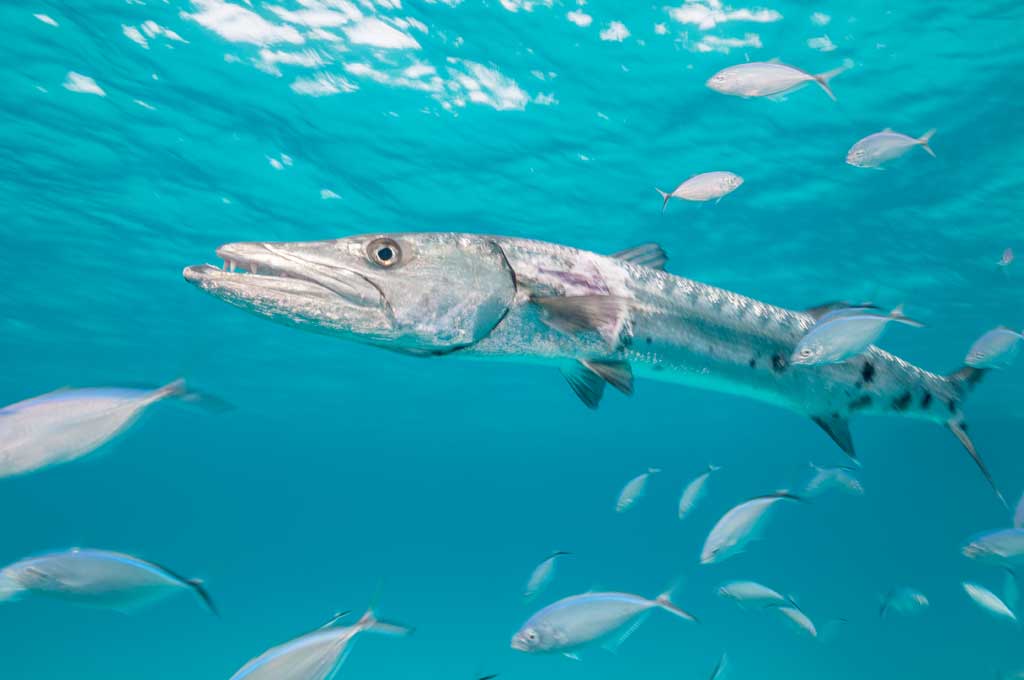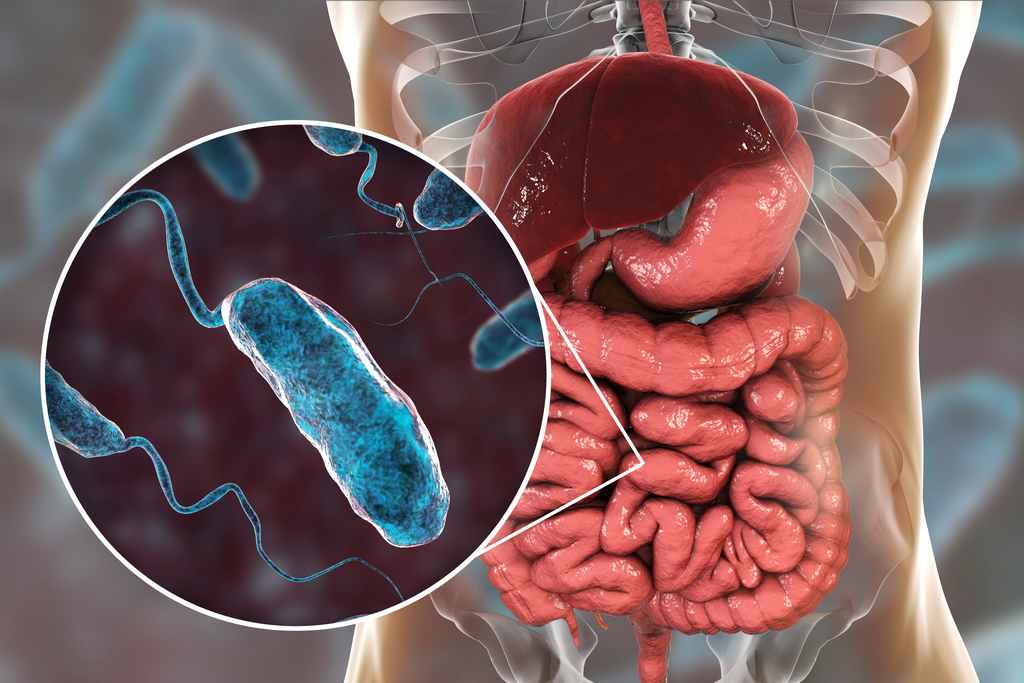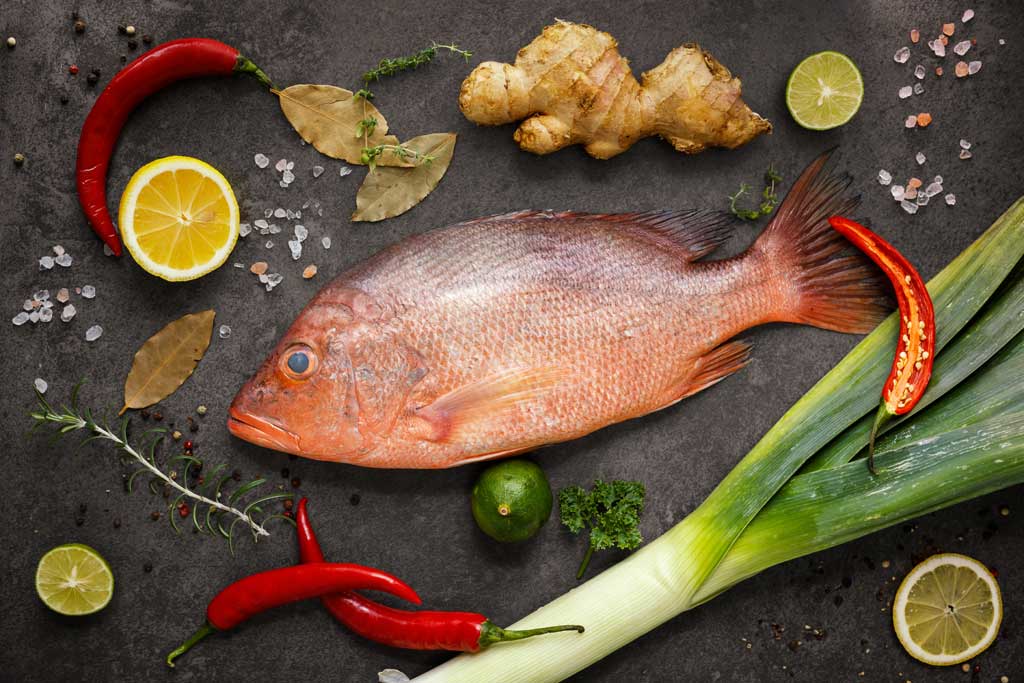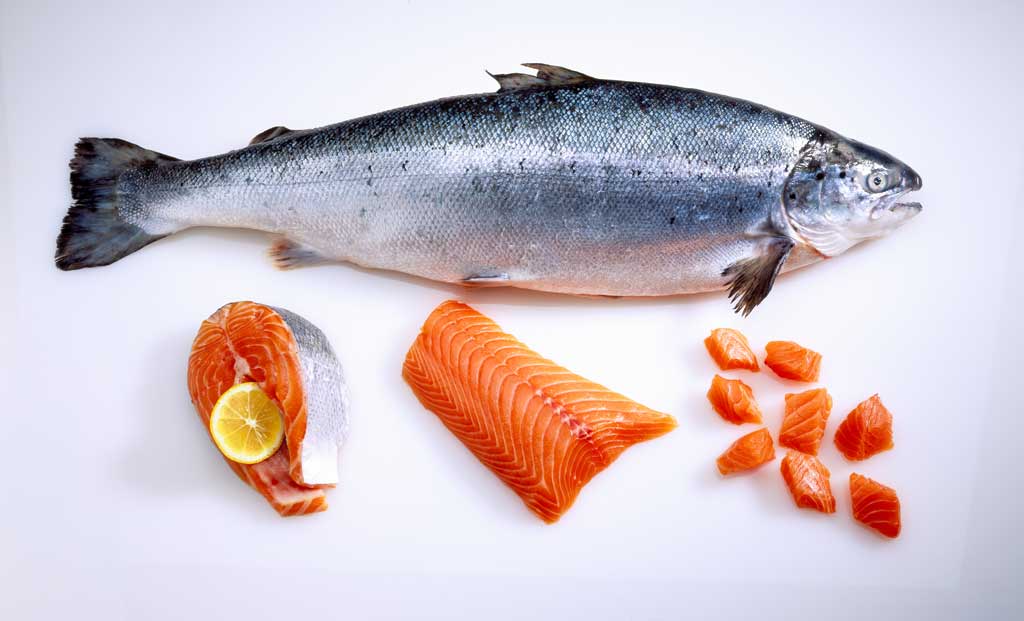Fish can carry harmful toxins in their systems that may not be destroyed when they are cooked. The two common two types of seafood illness that can be caused by fish are ciguatera and scombroid poisoning.
Neither type of seafood poisoning can be detected by taste or appearance. Neither can be prevented by cooking or freezing the fish.
 Image Source: Shutterstock
Image Source: Shutterstock Scombroid Poisoning
Scombroid poisoning is a food illness caused by the consuming certain species of fish contaminated with scombrotoxin (histamine) as a result of decomposition (inadequate refrigeration during processing or storage). Certain kinds of fish, especially dark meat fish, are more prone to produce histamine toxicity. These species include tuna, mahi-mahi, marlin, bluefish, sardines, anchovy, bonito, herring and mackerel.
Histamine toxicity is sometimes confused with an allergic reaction to fish because the symptoms are similar. But, because bacteria break down the the flesh of the fish (due to improper refrigeration) to form the histamine – it is considered a food illness. Furthermore, individuals with no history of allergies whatsoever, may be affected.
Scombroid Poisoning Symptoms
Symptoms typically develop rapidly (from 10 minutes to 2 hours after consumption) and can last up to a few days. The range of symptoms experienced is quite wide and may include:
- An oral burning or tingling sensation;
- Skin rash and localized inflammation;
- Hypotension (drop in blood pressure), headaches, dizziness, and flushing;
- Nausea, vomiting, and diarrhea;
Rarely, breathing problems or an irregular heart beat may occur. The elderly or individuals with weak immune systems may require hospital treatment. The symptoms usually resolve themselves within 24 hours.
 Image Source: Shutterstock
Image Source: Shutterstock Scombroid Prevention
Fish contaminated with histamine may have a peppery, sharp, salty, taste or “bubbly” feel but will usually look, smell, and taste normal. The key to prevention is to make sure that the fish is properly iced or refrigerated at temperatures <38°F (<3.3°C), or immediately frozen after it is caught. Cooking, smoking, canning, or freezing will not destroy histamine in contaminated fish.
No test is 100% reliable for assessing fish for this toxin or poison. Cooking kills the bacteria, but toxins remain in the tissues and can be absorbed after the food is ingested.
Preventing Scombroid Fish Poisoning
- Refrigerate fish (41°F or less) from the time of capture to the time it is cooked.
- Fish with a bad odor or “honey-combed” appearance should not be consumed.
- Purchase fish only from reputable retail outlets.
Reference: CDC – Food Poisoning from Marine Toxins
Ciguatera Poisoning
Ciguatera fish poisoning (or ciguatera), the most common form of algal-induced seafood poisoning, is an illness caused by eating contaminated tropical marine reef fish that contain toxins produced by a marine microalgae called Gambierdiscus toxicus, a microscopic algae common in the tropics.
 Image Source: Shutterstock
Image Source: Shutterstock Ciguatera Poisoning Symptoms
People who have ciguatera poisoning may experience nausea, vomiting, diarrhea, muscle weakness, joint aches, headache, dizziness, and low blood pressure. A characteristic symptom is “hot-cold reversal”; hot items feel cold and cold items feel hot.
Symptoms may begin within 15 minutes to 24 hours after eating affected fish. Most people are better in a few days, but in some cases symptoms have lasted for months or even years.
Ciguatera Prevention
People should take the following precautions to prevent ciguatera fish poisoning:
- Avoid or limit consumption of reef fish.
- Never eat high-risk fish such as barracuda or moray eel.
- Avoid the parts of the fish that concentrate ciguatera toxin: liver, intestines, roe, and head.
Remember that ciguatera toxins do not affect the texture, taste, or smell of fish, and they are not destroyed by gastric acid, cooking, smoking, freezing, canning, salting, or pickling.
Ciguatera Treatment
There is no specific antidote for ciguatoxin or maitotoxin poisonings. People who have ciguatera can only be treated for their symptoms.
After recovering from ciguatera poisoning, patients may want to avoid any fish, nuts, alcohol, or caffeine for at least 6 months as they may cause a relapse in symptoms.
Ciguatera Basic Facts
- The toxin may be found concentrated in large reef fish, most commonly: black grouper, blackfin snapper, cubera snapper, dog snapper, greater amberjack, hogfish, horse-eye jack, king mackerel, and yellowfin grouper have been known to carry ciguatoxins.
- The CDC recommends never eating moray eel or barracuda.
- These fish live in coral reef waters and accumulate the toxin when they eat smaller reef fish which feed on the dinoflagellates.
- The areas of most concern include the Caribbean Sea, Hawaii, and coastal Central America – but more than 400 fish species are known to become toxic. In U.S. waters, ciguatera occurs in Hawaii, Guam, southern Florida, Puerto Rico, the U.S. Virgin Islands, and occasionally in the Gulf of Mexico, extending around the southeast U.S. coast as far north as North Carolina.
- Ciguatera-causing algae are abundant in the Caribbean, and ocean warming would enable some of those species to move northward, increasing its presence in the Gulf of Mexico and U.S. southeast Atlantic. Warmer temperatures could also mean larger and longer blooms of harmful algae, including those that produce ciguatoxins.
- With fish from ciguatera endemic areas being shipped nationwide, poisonings can potentially occur in any areas in the United States.
- Ciguatera toxin tends to accumulate in large predator fish (weight over 2 Kg or about 4.5 lbs), such as the barracuda and other carnivorous reef fish, because they eat other fish that consume toxin-producing algae (dinoflagellates), which live in coral reef waters. The toxin has highest concentrations in fish visceral and sex organs.
- Ciguatera toxin is harmless to fish, but poisonous to humans.
- The toxin is odorless and tasteless, and cooking does not destroy the toxin.
Reference: CDC – Food Poisoning from Marine Toxins
Spoiled Fish
Spoiled fish, the result of poor food handling practices, can also cause dramatic gastrointestinal symptoms – nausea, vomiting, diarrhea, and abdominal pain. As with any other perishable food, fish need to be handled safely: keep uncooked fish cold, keep cooked fish hot, wash hands, utensils, and cutting boards before and after handling raw fish.
Selecting high-quality fish is easy when you know what to look for. A simple inspection of seafood selections at your local grocery store or fish market will tell you whether the fish is fresh or pre-frozen; handled properly or improperly; healthy or unhealthy.
 Image Source: Shutterstock
Image Source: Shutterstock Check the eyes for clarity
Before you handle the fish, check the eyes. They should be crystal-clear, plump, wet, and shiny, with no sunken features. If the eyes look good, you can bet with reasonable confidence that the fish is fresh and healthy.
Once the fish begins to deteriorate, the eyes dry out, become cloudy, and sink in or shrivel away. This indicates an unhealthy or improperly-handled fish.
Check the fins
The tail and dorsal fins of the fish should be healthy-looking, wet, and intact. A fish that’s been mishandled will have torn or ragged fins, while an older fish’s fins will be dry and brittle.
Torn and ragged fins probably belong to a fish that was netted or held for too long.
Poke the flesh
If the fish monger allows it, try touching the fish for further signs of health and freshness. It should feel cold, wet, and slippery, but not sticky. When pressed, it should spring back to its natural shape, just like if you were to press on your own flesh.
Fish that has lost its firm shape is no longer fresh. If it doesn’t spring back, it is a sure sign that the meat has softened.
Check the gills for vitality and color. When first caught, a fish’s gills appear bright red, and slowly darken over time. The brighter the color, the fresher the fish. The gills should also feel clean and cold, not slimy.
After several days, a fish’s gills will become dark brown or even black in color, indicating that the fish’s myoglobin has oxidized into metmyoglobin, which has a brickred-brown color. Mucus will build as time passes, too, so as the fish ages. the gills will become slimy and sticky.
Touch scales
Scales are designed to protect the fish from a harsh watery environment. When a fish is fresh, the scales will be shiny and firm, a veritable armor against the elements. Less-fresh fish will often shed scales as you run your hand over them, and they may appear dry and flaky.
Filleted Fish
Look for cracks in the filet that run between the muscles and collagen sheaths (the white lines running through the fish). Breaks in the muscle itself tend to indicate mishandling.
Pooling water also inside the container usually indicates that the fish is aging and losing its ability to hold moisture.
Additional Resources
- FDA – Fish and Fishery Products Hazards and Controls Guidance
https://www.fda.gov/food/seafood-guidance-documents-regulatory-information/fish-and-fishery-products-hazards-and-controls-guidance-4th-edition - Fish and Shellfish Poisoning
http://www.hopkinsmedicine.org/healthlibrary/conditions/travel_medicine/what_is_fish_and_shellfish_poisoning_85,P01434 - Paralytic Shellfish Poison (PSP)
http://www.doh.wa.gov/CommunityandEnvironment/Shellfish/BiotoxinsIllnessPrevention/Biotoxins/ParalyticShellfishPoison - Food Poisoning from Marine Toxins
http://wwwnc.cdc.gov/travel/yellowbook/2014/chapter-2-the-pre-travel-consultation/food-poisoning-from-marine-toxins - South Dakota Department of Health – Algal Toxins
https://doh.sd.gov/diseases/infectious/diseasefacts/AlgalToxins.aspx
